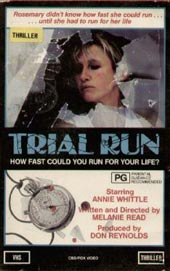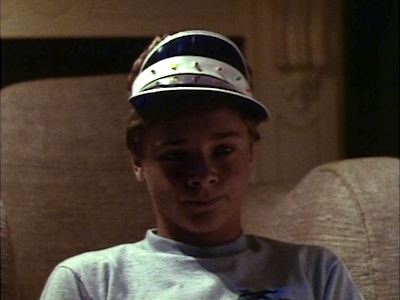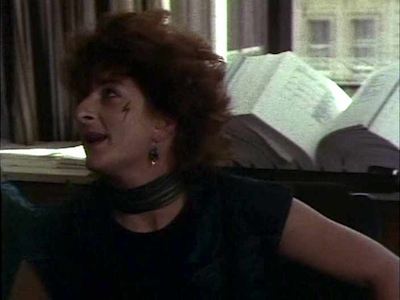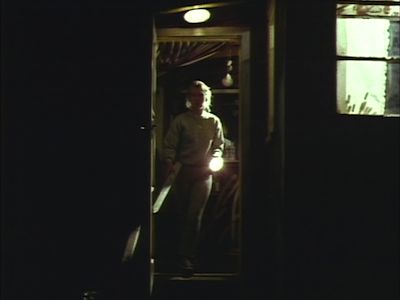(1984,NZ)

... until she had to run for her life "


An interesting, if ultimately both underwhelming and frustrating, genre piece from New Zealand. Directed by Melanie Read – the first film both written and directed by a woman in that country – it was intended as a feminist riposte to the slasher film. Although, TRIAL RUN is no SLUMBER PARTY MASSACRE (1982).
 |
|
| C'mon, we were all wearing these in 1984 |
Rosemary Edmonds (Annie Whittle) is a writer and photographer who is commissioned to document the lives of a rare colony of penguins at a picturesque bay – and takes up residence at an isolated country cottage nearby. She is also in training for a cross country run, and her computer mad teenage son Michael (Stephen Tozer) generates a training schedule for her – which includes running to the nearest telephone box (which you just know will come into play later on). Although isolated, the cottage is close enough for Michael and her daughter, Anna (Philippa Mayne), to join her for running sessions.
Rosemary's husband, James (Chris Broun) is distracted and perhaps adulterous – it is more than hinted that he is having an affair with her best friend Frances (Judith Gibson) (a borderline goth who sports a rather bizarre black lightening strike on her cheek). Rosemary seems oblivious to this as she tries to start work, but takes an instant dislike to her neighbour Alan West (Martyn Sanderson), whose dog growls and eventually attacks her. Although Alan seems amiable enough to start off with, Rosemary suspects him of being behind a series of intimidating incidents in and around the cottage – starting with scattering her logs and chopping down her flowers before progressing to more sinister acts. Jason Voorhees eat your heart out.
Her suspicion of Alan West grows when another neighbour (Lee Grant) tells her that West's wife left him and was the previous inhabitant of the cottage where she is currently staying. The neighbour tells her that the wife died in the cottage, but doesn't say how or why. Despite Frances coming to keep Rosemary company, the attacks on the cottage continue; increasing in their ferocity as an unseen presence creeps and then runs around in the dark…
 |
|
| Perhaps we weren't all sporting this look, however |
The director has gone on record as saying that she wanted to create a non-stereotyped role for a woman: “I wanted to choose an area where I thought the most damage had already been done - the thriller/horror genre.” Arguably an admirable aim, but it is hampered by a glacial turn by Edmonds as Rosemary, who is thoroughly unsympathetic as the rather grumpy woman-in-peril. Given the throwaway comments about 'woman's libbers' and the like, even though we don't get to see who (or what) the true nature of the threat is until the end it's fair to assume that it is meant to be a masculine one. Rosemary's determination not to leave the cottage – even though everyone tells her she should – is an obvious refusal to bow to male dominance (even a female cop tells her it would be best to get a 'man in the house' for her safety). Again, this would have been far more interesting had the lead been a sympathetic one. Rather than come across as strong and independent, Rosemary comes across as supremely selfish – with her wishes trumping everyone else's (be they male or female). The ultimate irony being that for all her would-be strength against adversity, all it leads to is not triumph but ultimately tragedy. In other words, the director trips herself up amongst the subgenre's many trappings – and in the end this is still a film about a woman being menaced (and making all the men either sinister, disinterested or borderline autistic is hardly a fair balance).
Also, whilst it would be pointless to argue that sexism was not an issue in many subgenre films of the time it is also important to point out that the slasher movie was already rife with female characters bucking the trend and fighting back – especially those Final Girls. Surely Laurie Strode, Ginny Field or Marti Gaines had already turned on its head the cliché of the fainting horror movie heroine? Here were women fighting back by whatever means necessary when, in most cases, the men folk proved next to useless in their traditional roles as protectors. Importantly, however, the lead females in HALLOWEEN (1978), FRIDAY THE 13TH PART II and HELL NIGHT (both 1981) were not only resourceful but likeable also.
 |
|
| The closing scenes of TRIAL RUN mimick the wilderness terrors of FRIDAY THE 13TH (1980), but to a lesser effect |
Unfortunately, for the first two-thirds of the movie the director is seemingly also intent on cementing an evident dislike for the horror/thriller genre, which apparently goes beyond inverting female stereotypes and goes towards inverting what makes a thriller. In other words, for much of its running time (no pun intended) TRIAL RUN seems obstinately hellbent on avoiding being thrilling in any way shape or form (you could be forgiven for thinking that you are watching a Kiwi CHARIOTS OF FIRE for much of it). However, Read does shift gears in the closing third of the film and, credit to her, successfully builds some suspense from the isolated setting and not knowing what is behind those black windows. In a similar way (although much less so), the film is reminiscent of the Australian nature-fights-back film LONG WEEKEND (1978) with seemingly normal bird sounds emerging from the darkness; amplified in both sound and potential threat.
Admittedly, by the end of the film I was half hoping that the threat would turn out to be a giant mutant penguin. Sadly, that was not to be – although the answer to what the threat to Rosemary was is as delightfully loopy as any of the subgenre's most outlandish motives and demonstrates a twisted sense of humour missing from the rest of the film. Well, at least I hope it was meant to be a sense of humour!
However, there is the question: is this even a slasher movie? The answer ultimately is no it is not (the body-count is a mere two – and even they are arguable as we don't see the victims die). Having said that, the reason I thought it right to include it here is that Read incorporates enough of the subgenre's elements (including copious POV stalking shots around the cottage) to make it worthwhile to cover TRIAL RUN – and, as I said before, it was clearly meant to be an 'answer' to the slasher genre. Read also isn't above invoking some of the slasher movies' hoary old cliches, such as the cut phone line – and the scenes of Rosemary peering out of the cottage windows into the inky blackness are clearly imitative of those of Alice's last counsellor standing in FRIDAY THE 13TH (1980).
TRIAL RUN was made in and around Auckland in 1983. Ultimately, Read admitted that marketing the film as a feminist thriller “wasn't the smartest marketing move”. However, she is to be admired in tackling a very real inequality: behind the camera (20 out of 29 of the crew were also women). Perhaps the ultimate irony was that the film was sold to international video markets with titillating artwork falsely promising the exact exploitative thrills that Read was steadfastly avoiding.
BODYCOUNT 2  female:0 / male:2
female:0 / male:2
1)
Male hit with wooden pole
2) Male hit by car